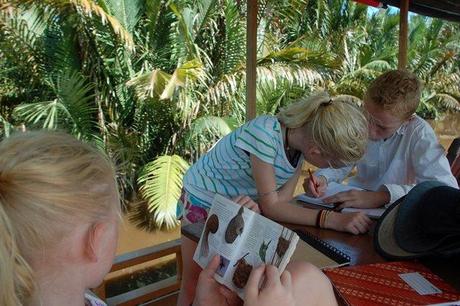
What kind of field guides should you bring cruising? The question of on board references came from a reader recently. It’s a good one, and it made me think about how we flubbed it and didn't have enough on board when we cut the docklines. Of course, everyone has different needs: some may not want any at all, and we probably skew above average. Here are the field guides that have earned their shelf space on Totem.
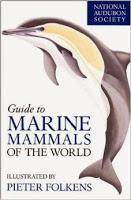 Marine mammals
Marine mammalsThe National Audubon Society’s Guide to Marine Mammals of the World has helped us ID animals from Puget Sound to Malaysia. From understanding the differences between oceanic dolphins and whales, to cataloging our identifications (we add a date and a note on the species information page) with successive sightings, this is one of the most frequently used guides on board.
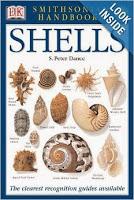 Shells
ShellsCollecting shells while beach combing is one of the simple pleasures of the cruising life. It’s not something that interested me previously, but that first season in the Sea of Cortez hooked me forever! Smithsonian Handbooks: Shells is a thorough guide with clear photographs that make identification easy. For accessible information about mollusc life cycles and more, we prefer the classic Golden Guide to Seashells of the World (ours is from the 60s, but there's much newer edition available). I’m happy to have both.
Sea life
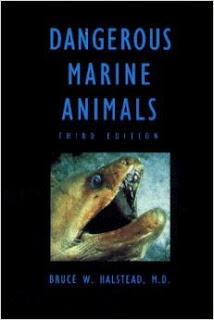 Despite the alarmist title, Dangerous Marine Animals: That Bite, Sting, Shock, or Are Non-Ediblehas helpful information about less savory sea life you might encounter, and was an early favorite on Totem. Our son borrowed it from his friend on another boat, fascinated by all the ways the ocean could kill you. Thankfully, it did not daunt his fascination with the sea: he was engrossed, and we all learned from it.
Despite the alarmist title, Dangerous Marine Animals: That Bite, Sting, Shock, or Are Non-Ediblehas helpful information about less savory sea life you might encounter, and was an early favorite on Totem. Our son borrowed it from his friend on another boat, fascinated by all the ways the ocean could kill you. Thankfully, it did not daunt his fascination with the sea: he was engrossed, and we all learned from it.For fish identification, we started with a generic “Reef Life” guide. While it was interesting and colorful, we rarely found exactly what we were looking for. No surprise, since it attempted to address reefs globally, and impossible task for such a big subject. For understanding what you see when you stick your head under water, regional books are far more useful.
Sea of Cortez Marine Animals: A Guide to the Common Fishes and Invertebrates was a winner while cruising Mexico. There’s a great companion guide, Sea of Cortez Marine Invertebrates that's worth looking for as well. We didn't have a copy of the latter when we headed up into the Sea, but were able to spend time looking through another boat’s edition. Although the title focuses on the SOC, the coverage area stretches to Panama.
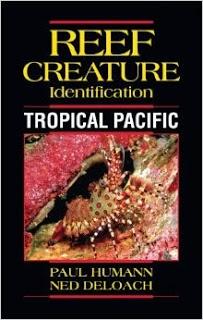 The volume of sea life in the South Pacific exploded compared to Mexico, and our existing guides were useless. Fortunately, a visit from my cousin to Bora Bora meant delivery of new books! After "shopping" from the guides on other boats, the clear winner was Reef Fish Identification - Tropical Pacific by Gerald Allen, Roger Steene, et al. Our copy is now well worn, with color-coded dots alongside different entries to call out what we've seen along the way. The same publisher offers Reef Creature Identification as a companion guide, and for some regions, Reef Coral Identification as well. If you think you might enjoy snorkeling or diving, remember that that fish are just one dimension of the reef: without guides to the other marine life, you miss out on a lot of the environment around you.
The volume of sea life in the South Pacific exploded compared to Mexico, and our existing guides were useless. Fortunately, a visit from my cousin to Bora Bora meant delivery of new books! After "shopping" from the guides on other boats, the clear winner was Reef Fish Identification - Tropical Pacific by Gerald Allen, Roger Steene, et al. Our copy is now well worn, with color-coded dots alongside different entries to call out what we've seen along the way. The same publisher offers Reef Creature Identification as a companion guide, and for some regions, Reef Coral Identification as well. If you think you might enjoy snorkeling or diving, remember that that fish are just one dimension of the reef: without guides to the other marine life, you miss out on a lot of the environment around you.For Australia and west, our pick is the Indo-Pacific Coral Reef Field Guide - also by Allen and Steene. It’s one volume, and not that big, but it does a great job of explaining and exploring the many different kinds of marine life- from algae to corals to echinoderms to fish. It’s not an exhaustive review of species, but it’s enough, and the education it offers the layperson is excellent.
Sea foraging
The regional guides are more oriented towards pretty reef fish, but there are plenty of others we've seen and wanted to identify- especially if they were at the end of a fishing line! For general information, Scott Bannerot’s The Cruiser's Handbook of Fishing is the most complete book on the subject, full stop. Really not a field guide, but everything you need to know about catching, cleaning, and preparing fish. It’s not for everyone, but we've found marine foraging to be helpful and fun.
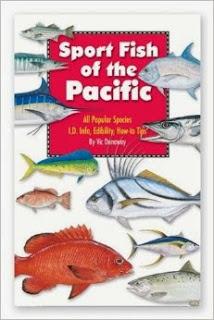
In Mexico, The Baja Catch is aimed at trailer-boaters or campers, but hands down the best guide we found for fishing in Mexico. It details locations along Baja, but the species information and tips are relevant all along Mexico's Pacific coast. It’s harder to find (well, harder to find affordably) but worth stalking. Sport Fish of the Pacific(Vic Dunaway) finally answered the question almost every other fish guide seemed to neglect: “but how good is it to eat?” Thank you, Vic, for the quick reference to help decide if a catch is a keeper, or a quick release! A copy of Goodson’s Fishes of the Pacific Coast picked up opportunistically at a swap meet turned out to have some of the best readable information about Pacific fish. With a coverage area from Alaska to Peru and the Galapagos, it doesn't try to cover every species you might see, but it does an excellent job of describing behaviors and distinguishing characteristics- something I find really interesting. It's nice to get beyond the pretty pictures and identification to learn more about what we're seeing underwater.
Birds
Peter Harrison’s Seabirds of the World is a great reference that’s helped us ID many of our sightings. While regionally specific guides for are best, the limitation to sea birds keeps this global guide useful- we can almost always make an identification.
 Just like fish guides, non-seabird bird guides really should be sourced by region. It was incredibly disappointing to realize in the USA that when most field guides described themselves as “North American”, they invariably meant “USA and Canada, and only cursory coverage of Mexico based on migratory patterns.” Ugh. That didn’t help the coming year and a half we were going to spend based in Mexico very much! We ended up with Princeton Guide of Birds of Mexico and Central America, and found it more helpful than any of the "North American" guides.
Just like fish guides, non-seabird bird guides really should be sourced by region. It was incredibly disappointing to realize in the USA that when most field guides described themselves as “North American”, they invariably meant “USA and Canada, and only cursory coverage of Mexico based on migratory patterns.” Ugh. That didn’t help the coming year and a half we were going to spend based in Mexico very much! We ended up with Princeton Guide of Birds of Mexico and Central America, and found it more helpful than any of the "North American" guides.I was surprised to find very few birds in the Pacific islands. Somehow I had the impression that they’d be rich with bird life: it just wasn't like that, unfortunately. We only rarely had occasion to even wish for a guide. That all changed once we reached Australia: there, PNG, and now Southeast Asia have rich and colorful bird life. I really wish we'd picked up Birds of Southeast Asia (Princeton Field Guides) before we left Australia.
Other critters
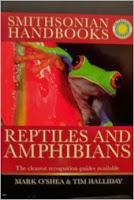
When we reached Australia, friends who were ending their cruising days gifted us with a couple of field guides from their on-board library. We've gotten a lot of use out of the Smithsonian Handbooks Reptiles and Amphibians and another Smithsonian Guide, Insects- Spiders and Other Terrestrial Arthropods has been similarly helpful. Maybe I was in denial about the number of creepy crawly and reptilian things we’d have the opportunity to identify (because, ew!) but it turns out… well, it turns out we do have plenty of those opportunities along our path through the tropical Pacific and into Southeast Asia, and now Mama knows just how poisonous some of them are. Jungle hike anyone?
Landscape
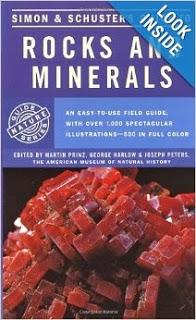 Sourcing guides for regional fauna has been much simpler than guides for landscape and flora. It’s a gap (I'd love to hear any recommendations!). In general this is covered in regional guides, but often not very well: it's simply easier to find commentary in a country guide about the flora than a book on the subject intended for the casual visitor.
Sourcing guides for regional fauna has been much simpler than guides for landscape and flora. It’s a gap (I'd love to hear any recommendations!). In general this is covered in regional guides, but often not very well: it's simply easier to find commentary in a country guide about the flora than a book on the subject intended for the casual visitor.Every time we looked at the stunning geography of Baja, I wished we had a geologist on board! This has been a recurring theme ever since. Lacking a geologist in our crew, we brought a copy of Simon & Schuster's Guide to Rocks and Minerals after our first year in Mexico. It helps, but a basic geology book would still be a good addition. The forms around us are sometimes so striking, they beg to be explained, yet we don’t always have the information available- and you can’t just “google it” from the middle of nowhere.
Our first year in Mexico, we really missed having good field guides. Somehow I manage to be continually late at getting the right books on board, but I'm getting better. Our global library grows over time, and we've shared regional books with those that followed us. Hopefully this helps others be more prepared than we were!
The links in this post to Amazon listings for each book include a referral from Totem. If you click through a link and subsequently make a purchase from Amazon, it throws a little change in our cruising kitty. Thank you for taking this into consideration, and helping to keep our family cruising!

